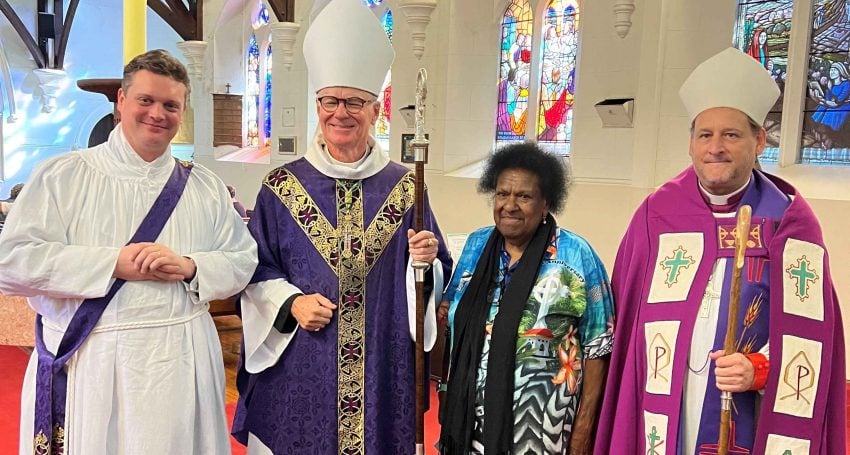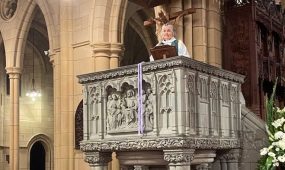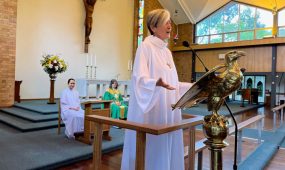Mothering Sunday: 27 March 2022 – St John’s East Malvern (Melbourne)
Homilies & Addresses
“I was not the best with sailing growing up, especially given that I am from the sea. I suffered terrible seasickness as a child. Whenever we sailed, I would always stay on deck, close to my father so I felt safe… As we sat around my father while he steered the rudder, he told us that, ‘The rainbow is God’s creation and God made this world in beautiful colours, including his people.’ He then told us not to be judgmental and to always respect, honour and listen to one another. He said that loving others is always the most important thing,” said Aunty Dr Rose Elu during her Mothering Sunday sermon at St John’s East Malvern

Good morning everyone. As a Torres Strait Islander on Aboriginal land, can I please, as a protocol, acknowledge the Traditional Custodians of this land we are all gathered on here at this sacred place and thank God for bringing us together at this beautiful place.
Can I also greet you all in my language of one of the top western islands of Torres Strait, called Saibai Island.
Mina kapu bathaynga mura ngithamulpa.
Good morning to you all.
Ina ngalpa garwoeydhamin nabi maygi boeradhanu.
For us to gather here at this holy place.
Ngalpa lake eso manin Awghadhapa nabi goeygipa
We give thanks to God for this day.
Ubilnga matha kedha ngitha ngurpemin ngoeymun igililmaynu a.
I would like you to learn our cultural way of life.
Pudhamin mura ngalpalpa ngulaygoepa yananab
So that each and every one of you understand.
My name is Aunty Rose Elu. My people are from the beautiful island of Saibai in the Torres Strait. I am very pleased to preach on Mothering Sunday, also known as Rose Sunday. This is a serendipitous day for me to preach given my Christian name and my vocation as a mother.
Children love to hear their parents and grandparents tell them stories. When I was young my father, who was a Saibai chief, would gather his children around him and tell us stories.
One of the stories my father told his children was about the migration of my people from Saibai in the Torres Strait Islands to the Country of the Gudang and Yadaykhenu on the Northern Peninsula Area of Queensland, commonly known as the Cape York Peninsula.
Advertisement
In the late-1940s, my people needed to migrate to seek safety from the threat of tsunami and malaria. We believe that God spoke into the hearts of our Elders and led them to the First Peoples of the peninsula, including to the Gudang and Yadaykhenu peoples.
My father and other Saibai Elders understood that in order to move to another people’s territory that they had to seek their consent and negotiate the way with them. So, my father, along with other Elders, went to the peninsula in Far North Queensland one night to do this.
He was met on the beach by the peninsula’s First Peoples who were waiting to welcome an unknown arrival. Somehow the Creator Spirit had spoken into their hearts and directed them to the beach to wait for and welcome our Elders who arrived by lugger.
Even though the Queensland Government drew up boundaries ahead of my people’s arrival without the consent of the peninsula’s Traditional Custodians, we knew that we had to seek permission from the Custodians and respect their protocols before we migrated. They welcomed my people graciously and we live together harmoniously to this day.
Advertisement
Before my mother, my siblings and I joined him, my father lived in an old army hut in Seisia on the peninsula. Before building what was to become our new home, he went to the peninsula’s First Peoples to seek their counsel about what particular trees would be best for building and he sought their permission to cut some down.
They showed him some trees between two hills. My father then set about building a house by hand for my family – Dad, Mum and 10 young folk. This involved moving a lot of very heavy timber.
So my father and his brothers built a raft out of recycled 44-gallon fuel drums to move the timber because it was easier to move it from one end of the coast to another than to move it by land. The make-shift rafts were pulled by ropes attached to dinghies, which were powered by oars. They then used a wagon that they had built to take the timber the rest of the way over land. The wagon was pulled by my father and his brothers using ropes. By the time Mum and we siblings came, my father and his brothers had built a seven bedroom home with a wraparound verandah.
I have vivid memories being welcomed by the Gudang and Yadaykhenu peoples. They became like adopted family to me. As an Elder, I now gather my grandchildren and grandnieces and grandnephews around me and tell them stories. This is one I like to tell them. When I was about six or seven, my father and uncles set sail in a small dinghy from Seisia to Thursday Island. We were not far from Seisia when our boat capsized in the waves. As I couldn’t swim yet, my father and uncles passed me from one to another to get me safely to shore. They then carried me to the village in Seisia where my adopted Aboriginal grandma and grandpa rubbed my legs with goanna oil to strengthen my exhausted limbs. It was common for my adopted Aboriginal family to lovingly care for us all with bush medicine when we were sick or injured.
God calls us to respect one another. This, in part at least, involves respecting people’s territories, traditions and protocols; seeking counsel and consent; and, caring for one another. Respect is also about being welcoming and inclusive. When respect is fostered, harmony presides. When respect is denied, harm is caused.
However, harm can be healed through reconciliation. The dictionary tells us that the etymology of the term “reconciliation” stems from the Latin “re”, which means “back”, and “conciliare” which means “bring together”.
In today’s Corinthians reading we learn about what it means to be reconciled to God as ambassadors for Jesus. And, we are also told that God has given us the ministry of reconciliation – of bringing back together. So reconciliation is sacred ground indeed.
Churches, especially Aboriginal and Torres Strait Islander clergy and Elders, are leaders when it comes to Reconciliation between First Nations peoples and non-Indigenous Australians. For example, National Reconciliation Week started as the Week of Prayer for Reconciliation in 1993 during the International Year of the World’s Indigenous Peoples. Today National Reconciliation Week is celebrated in workplaces, schools and childcare centres, community organisations, and by individuals Australia-wide.
For meaningful Reconciliation with First Peoples to happen in our churches, as part of this “bringing back together”, we need to gather as we are today and share stories about our histories and spiritualities.
I was not the best with sailing growing up, especially given that I am from the sea. I suffered terrible seasickness as a child. Whenever we sailed, I would always stay on deck, close to my father so I felt safe. Once when my family was out sailing in a lugger, I saw a huge rainbow at the back of Thursday Island, about 40km from the Queensland mainland. I pointed at the rainbow and remarked about the beautiful colours to my father. He asked me to go and gather my brothers and sisters who were below deck. As we sat around my father while he steered the rudder, he told us that, “The rainbow is God’s creation and God made this world in beautiful colours, including his people.” He then told us not to be judgmental and to always respect, honour and listen to one another. He said that loving others is always the most important thing.
As well as National Reconciliation Week, another key date in the Anglican Church’s calendar is the Coming of The Light. I’d like to share with you some of what this very special date means for Torres Strait Islander peoples.
Last year we celebrated the historic 150th anniversary of “The Coming of The Light”, commemorating the date that the London Missionary Society and Melanesian Christian leaders landed on the Torres Strait Island of Erub, introducing the Bible there.
Let me first and foremost reiterate that the landing of the LMS (London Missionary Society) to our shores was not a form of colonialism. It was merely bringing us the Gospel of Christ and trying to explore how we embrace the light of Christian faith in our own ways.
We ceased the tribal warfare and other cultural practices after learning and understanding what it means not to take someone’s life. After the missionaries understood and learnt our ways, they let us maintain our languages and some of our practices.
It is important for all Anglicans to appreciate that Jesus was present in my people before the Bible – before the Light of the Gospel – came to the Torres Strait Islands on that special day in 1871. Our spirituality lies in the land, sea and sky and since time immemorial our people have believed in a Creator – we just did not know yet that the Creator was the Christian God. As the custodians of the land, sea and sky, my people had already conceived that there was a Creator God before the Bible came to us.
While the Coming of The Light – the coming of the holy Bible – made this connection for us, we had already received God before the arrival of the English and Melanesian missionaries because Jesus was already with us.
So the Coming of The Light commemorates the Gospel coming to us and giving us a name for our Creator, whose image and likeness we are made in.
However, this is not the message that children’s Bibles published in the English language told me when I was growing up. When I was at Sunday School at age 10 or 11, I remember looking at an illustration of Jesus in a children’s Bible. Jesus was pictured as a man with very fair skin and sitting on his knees were very fair skinned children whom he was engaged in happy conversation with. At his feet sat a dark skinned girl who reminded me of me. “Why was Jesus not smiling at and talking with her also?” I wondered. I felt alienated, set apart, distanced by this illustration, rather than welcomed and included. Sharing a story like this takes a spirit of openness and courage. Reconciliation – being willing to “bring back together” – takes a spirit of openness and courage.
We have come a long way in the “bringing back together” process since this children’s Bible was published.
To conclude, I’d like to tell you one more story. When I was a teenager living in Seisia on the peninsula, I often asked my older brother who was an Anglican priest and my parents about the Coming of The Light. I didn’t understand why it was called this – I thought that our people had always been in the light. Their response was, “Yes. That is true. We were always in the light. When the missionaries brought us the light of scripture, the light of the Gospel unified with ours.” Let us then explore and interpret God in our Melanesian way.
God was on both sides of the beach.
Let us Pray.
This “Prayer of The Light” was made by one of the former Bishops of the Diocese of North Queensland, the late Bishop Eric Hawkey.
O’ Christ the light of the world
We thank you that your light shines among us
Draw us ever closer to you
So that free from sin
We may show forth the light of you glory in the world.
Amen.
Editor’s note: National Reconciliation Week (NRW) is held annually between 27 May and 3 June. This year’s theme is “Be Brave. Make Change.” Visit the Reconciliation Australia website for posters and resources and to register your NRW events. Find out about Diocesan NRW events by visiting the anglican focus ‘Events’ page.





